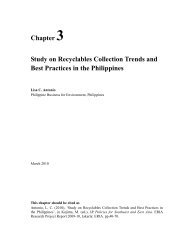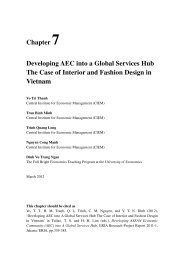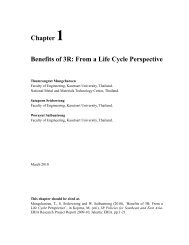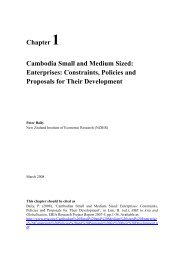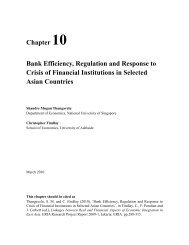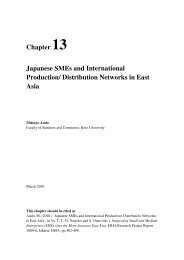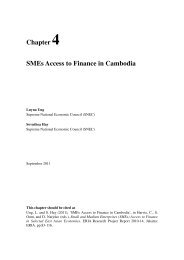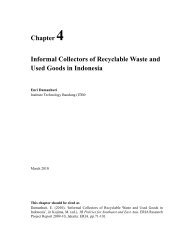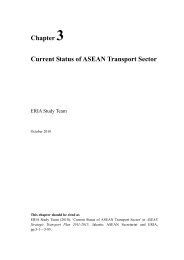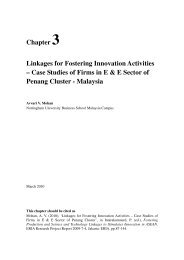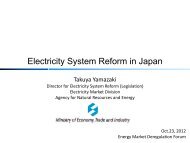Chapter 2 Cambodia - ERIA
Chapter 2 Cambodia - ERIA
Chapter 2 Cambodia - ERIA
Create successful ePaper yourself
Turn your PDF publications into a flip-book with our unique Google optimized e-Paper software.
such as fresh fruits, livestock, fish, shrimps, and prawns. However, <strong>Cambodia</strong> cannot yet enjoythe full potential of the program due to the absence of macroeconomic stability, a sound businessclimate, adequate legal framework, sufficient infrastructure, and effective governmentinstitutions. <strong>Cambodia</strong> has not yet fulfilled these prerequisites. 18 In addition, the lack ofinformation on regional markets, lack of government support in facilitating exports, and lack ofcapacity on the part of export entities are the main constraints in promoting <strong>Cambodia</strong>nagricultural exports to the region. 194.2. Mekong Subregional CooperationThe Mekong Subregion is heavily reliant on agriculture for economic development andlivelihood. The Mekong River is the main and largest water source in the region; it supports theproduction of various agricultural crops, especially rice. Thailand is the world’s biggest riceexporter, exporting about 8 million tons per year. Viet Nam exports approximately 6 million tonsper year. <strong>Cambodia</strong> exports much less than Thailand and Viet Nam, about 100,000 tons per year.The <strong>Cambodia</strong>n government has committed to increasing its exports to 1 million tons by 2015.Land expansion and the introduction of agricultural machinery transformed agriculture in theMekong Subregion from traditional subsistence to commercial farming, a trend that encouragesregional leaders to cooperate and find markets for their products.However, climate change and the decreasing water flow in the Mekong River are threateningagricultural development in the region. In early 2010, the Mekong River had its lowest waterflow in fifty years. A study done by the Mekong River Commission (MRC) revealed that thisphenomenon was caused mainly by extreme weather conditions that prevailed in the country—very low rainfall in the 2010 dry season following a particularly wet season in 2009.According to Jeremy Bird, chief executive officer (CEO) of the MRC, this phenomenon issending many people to the brink of serious poverty. “Difficulties in access to water make18 Hing Vutha and Noun Keosothea, 2006 Early Harvest Programme: Implications for <strong>Cambodia</strong>n Agriculture,CDRI Special Report, May 4, 2006, http://www.cdri.org.kh/webdata/download/sr/ehpe.pdf19 Chap and Chheang. “Trade liberalization under ACFTA and Its Possible Impacts on <strong>Cambodia</strong>n Industries”(unpublished research paper, Asian Development Bank, Manila, 2010b).107



